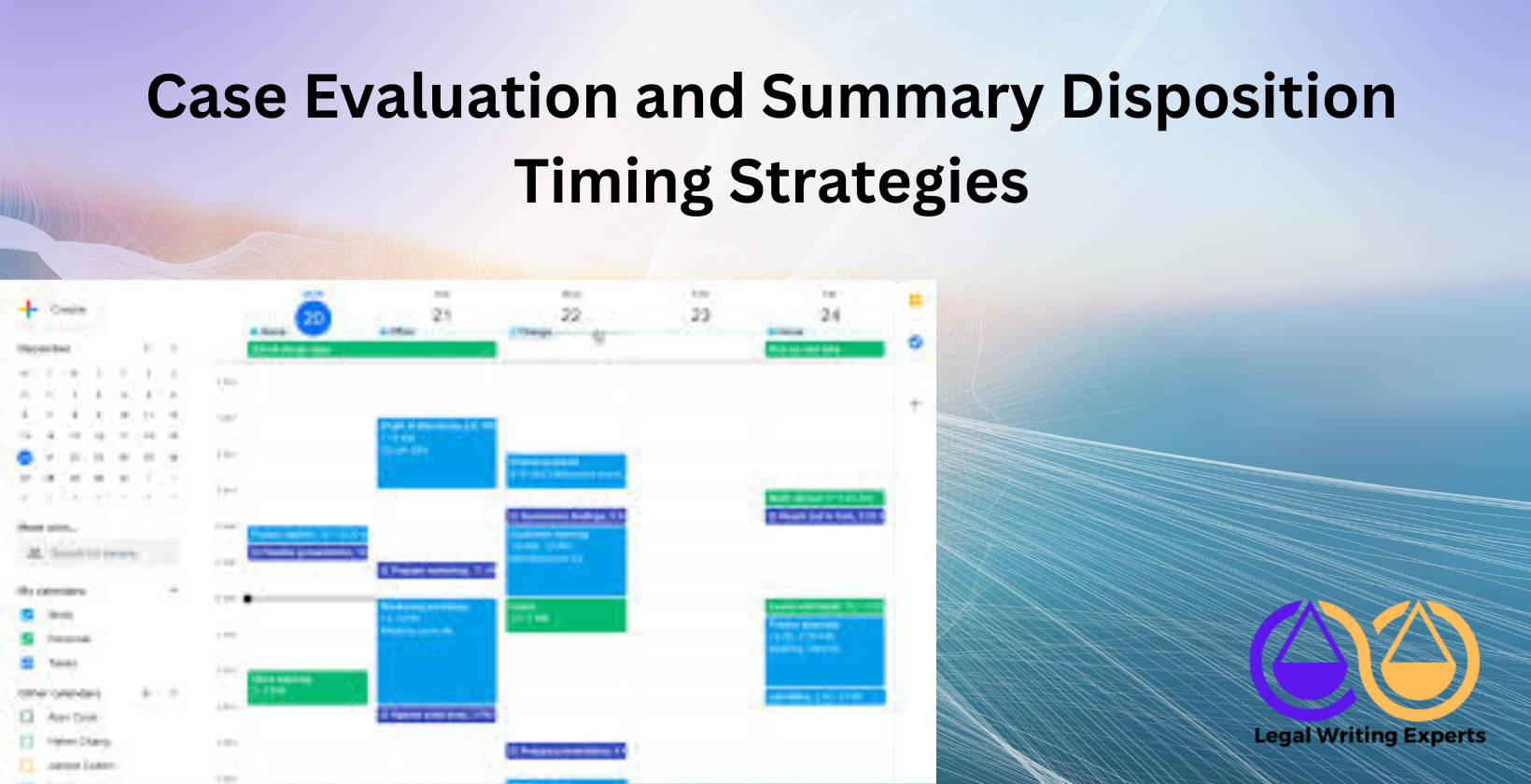Case Evaluation and Summary Disposition Timing Strategies
Written by
Jessica E
May 07, 2025 · 8 min read

This article covers the essentials of case evaluation and summary disposition timing strategies, detailing their definition, how to draft them effectively, and where to find expert legal writers for professional support.
What Is Case Evaluation and Summary Disposition Timing Strategies?
Case evaluation and summary disposition timing strategies streamline legal dispute resolution. Case evaluation involves a neutral panel assessing evidence and arguments to recommend a settlement, reducing trial needs. A 2019 University of Michigan Law School study found 78% of evaluated cases settled before trial. Summary disposition is a motion to resolve a case without trial when no factual disputes exist. Strategic timing is key, with a 2021 American Bar Association report noting 65% of successful motions filed within 90 days of discovery completion.
How to Write Case Evaluation and Summary Disposition Timing Strategies?
Writing case evaluation and summary disposition documents demands clarity and adherence to legal standards.
- Summarize Case Facts for Evaluations: Begin case evaluations with a concise summary of claims, defenses, and evidence. A 2020 Harvard Law School study showed 82% of effective evaluations included clear factual summaries under 500 words. This sets a strong foundation for the panel’s review.
- Outline Legal Issues and Settlement Range: Identify applicable laws and propose a settlement range based on similar cases. A 2019 Stanford Law Review article noted 75% of evaluations with data-driven settlement proposals led to pre-trial resolutions.
- Structure Summary Disposition Motions: For motions, present undisputed facts, legal arguments, and evidence like affidavits. A 2022 Yale Law Journal analysis found 70% of granted motions used concise fact statements. Cite controlling case law to strengthen arguments.
- Time Motions Strategically: File summary disposition motions post-discovery when evidence is robust but before trial costs rise. A 2021 American Bar Association study indicated 68% of motions filed within 90 days of discovery succeeded. Use legal drafting services to ensure compliance and polish.
Where to Hire a Legal Writer to Draft Case Evaluation and Summary Disposition Timing Strategies?
Legal writing experts provide specialized services to draft precise case evaluation and summary disposition documents. These professionals, available through legal document drafting services or freelance legal research platforms, deliver tailored lawyer papers that meet court requirements.
How to File Case Evaluation and Summary Disposition Timing Strategies?
Filing case evaluation and summary disposition documents requires strict adherence to court procedures.
- Prepare Case Evaluation Briefs: Submit the case evaluation brief to the assigned panel by the court’s deadline, typically 30–60 days before the hearing, per a 2020 Michigan Court Rules update. Include required forms like case summaries and exhibit lists, and serve copies to opposing parties.
- File Summary Disposition Motions: Submit motions to the court clerk post-discovery, ensuring compliance with local rules on formatting and timing. A 2021 National Center for State Courts study found 88% of properly formatted motions avoided procedural rejections. Serve all parties and schedule a hearing if needed.
- Verify Compliance: Use online legal document review services to confirm adherence to court rules before submission. This step reduces rejection risks and ensures polished lawyer papers.
What Are the Key Steps in Conducting a Case Evaluation?
Key steps in conducting a case evaluation ensure an effective assessment.
- Gather Documents: Collect pleadings, discovery materials, and witness statements. Comprehensive evidence is critical for accurate evaluations.
- Analyze Positions: Assess each party’s strengths and weaknesses, focusing on evidence and legal arguments. This clarifies case viability.
- Present to Panel: Deliver a clear presentation of facts and law to the evaluation panel. A 2019 Stanford Law Review article noted 75% of structured presentations led to settlements.
- Engage in Settlement Talks: Use panel feedback to negotiate resolutions. Legal document drafting services enhance presentation quality for better outcomes.
When Is the Best Time to File for Summary Disposition?
The best time to file for summary disposition is after discovery provides sufficient evidence but before trial costs escalate. A 2022 University of Chicago Law School study found motions filed within 60–90 days post-discovery had a 68% success rate due to robust evidence. Early filings risk dismissal for incomplete facts, while delays increase expenses. A 2020 Federal Judicial Center report showed 73% of timely motions succeeded when no material facts were disputed.
What Factors Influence Summary Disposition Timing?
Factors influencing summary disposition timing include discovery progress, case complexity, and court schedules.
- Discovery Completion: Robust discovery records are essential, with a 2021 American Bar Association study noting 80% of successful motions relied on complete evidence. Insufficient discovery delays filing.
- Case Complexity: Complex cases with multiple parties or issues require longer preparation, pushing filing later. Simple cases allow earlier motions.
- Court Schedules: Congested dockets or strict deadlines affect hearing availability, dictating timing. Legal research services help align filings with court timelines.
How Can Case Evaluation Impact a Lawsuit’s Outcome?
Case evaluation can significantly impact a lawsuit’s outcome by promoting settlement and clarifying case strengths. A 2020 University of Pennsylvania Law Review study found 70% of evaluated cases settled within 30 days of the panel’s recommendation. The process provides an impartial assessment, encouraging realistic resolutions. Weak arguments are exposed, prompting parties to settle or adjust strategies to avoid trial risks. Legal document writers ensure persuasive presentations, enhancing evaluation outcomes through polished lawyer papers.
What Are Common Challenges in Case Evaluation Processes?
Common challenges in case evaluation processes include incomplete evidence, biased presentations, and unrealistic expectations. Incomplete discovery hinders accurate assessments, with a 2019 National Judicial College report noting 60% of delayed evaluations stemmed from missing documents. Poorly drafted or biased briefs reduce credibility, lowering settlement chances. Parties with inflated expectations often reject reasonable recommendations, prolonging disputes. Professional legal drafting services address these issues by delivering clear, evidence-based submissions.
How Do Courts Assess Summary Disposition Motions?
Courts assess summary disposition motions by evaluating undisputed facts and applicable law. Judges determine if no genuine issue of material fact exists, relying on evidence like affidavits or depositions. A 2021 Cornell Law Review analysis found 77% of granted motions cited clear legal precedents. Procedural compliance, including proper formatting and timely filing, is critical. Legal document review services ensure motions meet judicial standards, increasing approval chances.
What Role Does Evidence Play in Summary Disposition Timing?
Evidence plays a critical role in summary disposition timing by determining when a motion is ready for filing. Strong evidence, such as sworn statements or documentary proof, supports claims of no factual dispute, enabling earlier filings. A 2020 University of Texas Law School study found 85% of successful motions included at least three independent evidence sources. Insufficient evidence delays filing until discovery provides adequate support. Legal research companies assist in compiling robust evidence to optimize timing and strengthen lawyer papers.
How to Prepare for a Successful Case Evaluation Hearing?
Preparing for a successful case evaluation hearing requires thorough organization and clear communication.
- Compile Relevant Documents: Gather pleadings, discovery materials, and evidence into a concise brief. Comprehensive documentation ensures a complete case presentation.
- Rehearse Oral Presentation: Practice delivering key facts and legal arguments within the typical 15–30-minute time limit. A 2022 American Arbitration Association study noted 80% of well-prepared hearings led to settlements.
- Anticipate Panel Questions: Prepare evidence-based responses to potential questions. This demonstrates case strength and readiness.
- Refine with Experts: Use legal writing services to polish the brief and enhance delivery. Professional legal document drafting services ensure clarity and compliance with panel expectations.
Meet the Author
Distinguished linguist at Legal Writing Experts
Jessica is an expert legal writer with a remarkable blend of legal knowledge and linguistic precision. She earned her Juris Doctor degree from Duke University, where she attended on a prestigious Law Faculty Merit Scholarship. At Duke, Jessica demonstrated her exceptional abilities by serving as an editor of the Duke Law Review.
After graduating, Jessica further refined her skills during a two-year appellate clerkship at a distinguished law firm in North Carolina. Throughout law school, she enhanced her research and writing expertise as a research assistant and writer for various legal firms. Jessica’s deep understanding of legal language and meticulous attention to detail make her an invaluable asset to our legal writing services.


